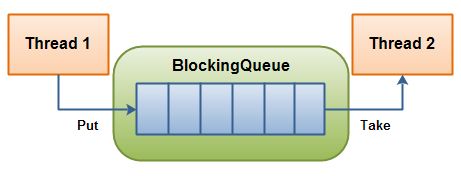【Java併發之】BlockingQueue
本文主要講的是併發包中涉及到的集合,關於普通集合,請參考【java 集合概覽】
一、什麼是BlockingQueue
BlockingQueue即阻塞佇列,從阻塞這個詞可以看出,在某些情況下對阻塞佇列的訪問可能會造成阻塞。被阻塞的情況主要有如下兩種:
1. 當佇列滿了的時候進行入佇列操作
2. 當佇列空了的時候進行出佇列操作
因此,當一個執行緒試圖對一個已經滿了的佇列進行入佇列操作時,它將會被阻塞,除非有另一個執行緒做了出佇列操作;同樣,當一個執行緒試圖對一個空佇列進行出佇列操作時,它將會被阻塞,除非有另一個執行緒進行了入佇列操作。
在Java中,BlockingQueue的介面位於java.util.concurrent
二、BlockingQueue的用法
阻塞佇列主要用在生產者/消費者的場景,下面這幅圖展示了一個執行緒生產、一個執行緒消費的場景:
負責生產的執行緒不斷的製造新物件並插入到阻塞佇列中,直到達到這個佇列的上限值。佇列達到上限值之後生產執行緒將會被阻塞,直到消費的執行緒對這個佇列進行消費。同理,負責消費的執行緒不斷的從佇列中消費物件,直到這個佇列為空,當佇列為空時,消費執行緒將會被阻塞,除非佇列中有新的物件被插入。
三、BlockingQueue介面中的方法
阻塞佇列一共有四套方法分別用來進行insert
remove和examine,當每套方法對應的操作不能馬上執行時會有不同的反應,下面這個表格就分類列出了這些方法: asdf
| - | Throws Exception | Special Value | Blocks | Times Out |
|---|---|---|---|---|
| Insert | add(o) | offer(o) | put(o) | offer(o, timeout, timeunit) |
| Remove | remove(o) | poll() | take() | poll(timeout, timeunit) |
| Examine | element() | peek() |
這四套方法對應的特點分別是:
1. ThrowsException:如果操作不能馬上進行,則丟擲異常
2. SpecialValue:如果操作不能馬上進行,將會返回一個特殊的值,一般是true或者false
3. Blocks:如果操作不能馬上進行,操作會被阻塞
4. TimesOut:如果操作不能馬上進行,操作會被阻塞指定的時間,如果指定時間沒執行,則返回一個特殊值,一般是true或者false
需要注意的是,我們不能向BlockingQueue中插入null,否則會報NullPointerException。
四、BlockingQueue的實現類
BlockingQueue只是java.util.concurrent包中的一個介面,而在具體使用時,我們用到的是它的實現類,當然這些實現類也位於java.util.concurrent包中。在Java6中,BlockingQueue的實現類主要有以下幾種:
1. ArrayBlockingQueue
2. DelayQueue
3. LinkedBlockingQueue
4. PriorityBlockingQueue
5. SynchronousQueue
下面我們就分別介紹這幾個實現類。
4.1 ArrayBlockingQueue
ArrayBlockingQueue是一個有邊界的阻塞佇列,它的內部實現是一個數組。有邊界的意思是它的容量是有限的,我們必須在其初始化的時候指定它的容量大小,容量大小一旦指定就不可改變。
ArrayBlockingQueue是以先進先出的方式儲存資料,最新插入的物件是尾部,最新移出的物件是頭部。下面是一個初始化和使用ArrayBlockingQueue的例子:
BlockingQueue queue = new ArrayBlockingQueue(1024);
queue.put("1");
Object object = queue.take();
4.2 DelayQueue
DelayQueue阻塞的是其內部元素,DelayQueue中的元素必須實現 java.util.concurrent.Delayed介面,這個介面的定義非常簡單:
public interface Delayed extends Comparable<Delayed> {
long getDelay(TimeUnit unit);
}
getDelay()方法的返回值就是佇列元素被釋放前的保持時間,如果返回0或者一個負值,就意味著該元素已經到期需要被釋放,此時DelayedQueue會通過其take()方法釋放此物件。
從上面Delayed 介面定義可以看到,它還繼承了Comparable介面,這是因為DelayedQueue中的元素需要進行排序,一般情況,我們都是按元素過期時間的優先順序進行排序。
例1:為一個物件指定過期時間
首先,我們先定義一個元素,這個元素要實現Delayed介面
public class DelayedElement implements Delayed {
private long expired;
private long delay;
private String name;
DelayedElement(String elementName, long delay) {
this. name = elementName;
this. delay= delay;
expired = ( delay + System. currentTimeMillis());
}
@Override
public int compareTo(Delayed o) {
DelayedElement cached=(DelayedElement) o;
return cached.getExpired()> expired?1:-1;
}
@Override
public long getDelay(TimeUnit unit) {
return ( expired - System. currentTimeMillis());
}
@Override
public String toString() {
return "DelayedElement [delay=" + delay + ", name=" + name + "]";
}
public long getExpired() {
return expired;
}
}
設定這個元素的過期時間為3s
public class DelayQueueExample {
public static void main(String[] args) throws InterruptedException {
DelayQueue<DelayedElement> queue= new DelayQueue<>();
DelayedElement ele= new DelayedElement( "cache 3 seconds",3000);
queue.put( ele);
System. out.println( queue.take());
}
}
執行這個main函式,我們可以發現,我們需要等待3s之後才會列印這個物件。
其實DelayQueue應用場景很多,比如定時關閉連線、快取物件,超時處理等各種場景,下面我們就拿學生考試為例讓大家更深入的理解DelayQueue的使用。
例2:把所有考試的學生看做是一個DelayQueue,誰先做完題目釋放誰
首先,我們構造一個學生物件
public class Student implements Runnable,Delayed{
private String name; //姓名
private long costTime;//做試題的時間
private long finishedTime;//完成時間
public Student(String name, long costTime) {
this. name = name;
this. costTime= costTime;
finishedTime = costTime + System. currentTimeMillis();
}
@Override
public void run() {
System. out.println( name + " 交卷,用時" + costTime /1000);
}
@Override
public long getDelay(TimeUnit unit) {
return ( finishedTime - System. currentTimeMillis());
}
@Override
public int compareTo(Delayed o) {
Student other = (Student) o;
return costTime >= other. costTime?1:-1;
}
}
然後在構造一個教師物件對學生進行考試
public class Teacher {
static final int STUDENT_SIZE = 30;
public static void main(String[] args) throws InterruptedException {
Random r = new Random();
//把所有學生看做一個延遲佇列
DelayQueue<Student> students = new DelayQueue<Student>();
//構造一個執行緒池用來讓學生們“做作業”
ExecutorService exec = Executors.newFixedThreadPool(STUDENT_SIZE);
for ( int i = 0; i < STUDENT_SIZE; i++) {
//初始化學生的姓名和做題時間
students.put( new Student( "學生" + (i + 1), 3000 + r.nextInt(10000)));
}
//開始做題
while(! students.isEmpty()){
exec.execute( students.take());
}
exec.shutdown();
}
}
我們看一下執行結果:
學生2 交卷,用時3
學生1 交卷,用時5
學生5 交卷,用時7
學生4 交卷,用時8
學生3 交卷,用時11
通過執行結果我們可以發現,每個學生在指定開始時間到達之後就會“交卷”(取決於getDelay()方法),並且是先做完的先交卷(取決於compareTo()方法)。
通過檢視其原始碼可以看到,DelayQueue內部實現用的是PriorityQueue和一個Lock:
4.3 LinkedBlockingQueue
LinkedBlockingQueue阻塞佇列大小的配置是可選的,如果我們初始化時指定一個大小,它就是有邊界的,如果不指定,它就是無邊界的。說是無邊界,其實是採用了預設大小為Integer.MAX_VALUE的容量 。它的內部實現是一個連結串列。
和ArrayBlockingQueue一樣,LinkedBlockingQueue 也是以先進先出的方式儲存資料,最新插入的物件是尾部,最新移出的物件是頭部。下面是一個初始化和使LinkedBlockingQueue的例子:
BlockingQueue<String> unbounded = new LinkedBlockingQueue<String>();
BlockingQueue<String> bounded = new LinkedBlockingQueue<String>(1024);
bounded.put("Value");
String value = bounded.take();
4.4 PriorityBlockingQueue
PriorityBlockingQueue是一個沒有邊界的佇列,它的排序規則和 java.util.PriorityQueue一樣。需要注意,PriorityBlockingQueue中允許插入null物件。
所有插入PriorityBlockingQueue的物件必須實現 java.lang.Comparable介面,佇列優先順序的排序規則就是按照我們對這個介面的實現來定義的。
另外,我們可以從PriorityBlockingQueue獲得一個迭代器Iterator,但這個迭代器並不保證按照優先順序順序進行迭代。
下面我們舉個例子來說明一下,首先我們定義一個物件型別,這個物件需要實現Comparable介面:
public class PriorityElement implements Comparable<PriorityElement> {
private int priority;//定義優先順序
PriorityElement(int priority) {
//初始化優先順序
this.priority = priority;
}
@Override
public int compareTo(PriorityElement o) {
//按照優先順序大小進行排序
return priority >= o.getPriority() ? 1 : -1;
}
public int getPriority() {
return priority;
}
public void setPriority(int priority) {
this.priority = priority;
}
@Override
public String toString() {
return "PriorityElement [priority=" + priority + "]";
}
}
然後我們把這些元素隨機設定優先順序放入佇列中
public class PriorityBlockingQueueExample {
public static void main(String[] args) throws InterruptedException {
PriorityBlockingQueue<PriorityElement> queue = new PriorityBlockingQueue<>();
for (int i = 0; i < 5; i++) {
Random random=new Random();
PriorityElement ele = new PriorityElement(random.nextInt(10));
queue.put(ele);
}
while(!queue.isEmpty()){
System.out.println(queue.take());
}
}
}
看一下執行結果:
PriorityElement [priority=3]
PriorityElement [priority=4]
PriorityElement [priority=5]
PriorityElement [priority=8]
PriorityElement [priority=9]
4.5 SynchronousQueue
SynchronousQueue佇列內部僅允許容納一個元素。當一個執行緒插入一個元素後會被阻塞,除非這個元素被另一個執行緒消費。


